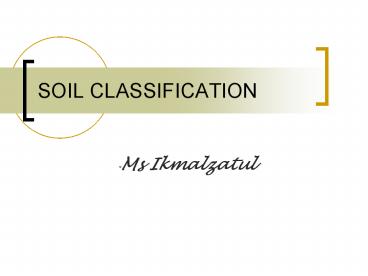SOIL CLASSIFICATION - PowerPoint PPT Presentation
1 / 29
Title:
SOIL CLASSIFICATION
Description:
Title: TxDOT Project 0-5205 Meeting Author: Abdulrahman Alhabshi Last modified by: user Created Date: 4/28/2002 5:43:05 PM Document presentation format – PowerPoint PPT presentation
Number of Views:388
Avg rating:3.0/5.0
Title: SOIL CLASSIFICATION
1
SOIL CLASSIFICATION
-Ms Ikmalzatul
2
TWO KINDS of Soil...
- Two kinds of soil in this world
- COARSE
- FINE
3
Fine-Grained vs. Coarse-Grained Soils
- U.S. Standard Sieve - No. 200
- 0.0029 inches
- 0.074 mm
4
Sieve Analysis (Mechanical Analysis)
- This procedure is suitable for coarse grained
soils - e.g. No.10 sieve . has 10 apertures per linear
inch
5
Hydrometer Analysis
- Also called Sedimentation Analysis
- Stokes Law
6
Grain Size Distribution Curves
7
Soil Plasticity
- Plasticity is a property that enables a soil to
undergo deformation without breaking. - Clays for instance are moulded into earthen pots
when its plastic state. - This property is characteristic on fined grained
soils only, in the presence of water. - When water is replaced by some other liquid , say
kerosene, the clay will behave as a granular
mass.
8
- Plasticity is due to clay minerals in the soils
and is exhibited only over a specific range of
moisture content. - Excessive water turns the soil into a suspension
(liquid state). - With gradual decrease in the water content, the
soil passes into a plastic state, then into a
semi-solid (or semi-plastic) state and finally
into a solid state.
9
Plastic state
Semi-solid state
10
- The water content at which these changes of state
occur called limits or indices. - Albert Atterberg, Swedish Soil Scientist
(1846-1916)..series of tests for evaluating soil
plasticity. He defined these limits as follows
the liquid limit (LL) is the water content at
which a soil passes from liquid to plastic state
the plastic limit (PL) is the water content at
which a soil passes from plastic to semi-solid
state and the shrinkage limit (SL) is the water
content at which a soil passes from semi solid
state.
11
- Further classification within fine-grained soils
(i.e. soil that passes 200 sieve) is done based
on soil plasticity. - Arthur Casagrande adopted these tests for
geotechnical engineering purposes
12
Atterberg Limits
- Consistency of fine-grained soil varies in
proportion to the water content
13
Liquid Limit (LL or wL)
- Empirical Definition
- The moisture content at which a 2 mm-wide groove
in a soil pat will close for a distance of 0.5 in
when dropped 25 times in a standard brass cup
falling 1 cm each time at a rate of 2 drops/sec
in a standard liquid limit device
14
Engineering Characterization of Soils
Soil Properties that Control its Engineering
Behavior
Particle Size
fine-grained
coarse-grained
- Soil Plasticity
- Particle/Grain Size Distribution
- Particle Shape
15
Clay Morphology
- Scanning Electron Microscope (SEM)
- Shows that clay particles consist of stacks of
plate-like layers
16
Soil Consistency Limits
- Albert Atterberg (1846-1916) Swedish Soil
Scientist - .. Developed series of tests for evaluating
consistency limits of soil (1911) - Arthur Casagrande (1902-1981)
- Adopted these tests for geotechnical
engineering purposes
17
Arthur Casagrande (1902-1981)
- Joined Karl Terzaghi at MIT in 1926 as his
graduate student - Research project funded by Bureau of Public Roads
- After completion of Ph.D at MIT Casagrande
initiated Geotechnical Engineering Program at
Harvard - Soil Plasticity and Soil Classification (1932)
18
Casagrande Apparatus
19
Casagrande Apparatus
20
Casagrande Apparatus
21
Liquid Limit Determination
22
Plastic Limit (PL, wP)
- The moisture content at which a thread of soil
just begins to crack and crumble when rolled to a
diameter of 1/8 inches
23
Plastic Limit (PL, wP)
24
Plasticity Index ( PI, IP )
- PI LL PL
- or IPwL-wP
- Note These are water contents, but the
percentage sign is not typically shown.
25
Plasticity Chart
26
USCS Classification Chart
27
USCS Classification Chart
28
Plasticity Chart
29
THE END































